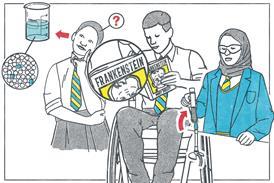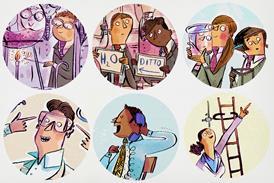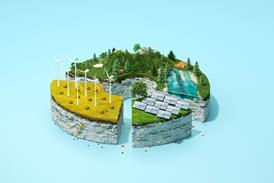Remove misunderstanding from the equation by letting learners experiment with simulations they can build themselves

I am an avid user of PhET simulations in the classroom. I wrote to PhET to suggest a new equilibrium simulation for post-16s that would encapsulate the ideas of forward and reverse rate equations and, crucially, concentrations. They were very receptive to the idea, but the price tag for a single simulation was around £73,000, so I decided to make my own in Microsoft Excel.
I am an avid user of PhET simulations in the classroom (rsc.li/44raUF8). I wrote to PhET to suggest a new equilibrium simulation for post-16s that would encapsulate the ideas of forward and reverse rate equations and, crucially, concentrations. They were very receptive to the idea, but the price tag for a single simulation was around £73,000, so I decided to make my own in Microsoft Excel.
Simulations are an excellent, visual and mess free way to probe understanding quickly and safely. They’re a great way to remove the teacher from the equation and let learners take the wheel. If at the same time they learn to excel at Excel and develop their computer skills, then even better.
Simulations are an excellent, visual and mess free way to probe understanding quickly and safely (rsc.li/4exzYz4). They’re a great way to remove the teacher from the equation and let learners take the wheel. If at the same time they learn to excel at Excel and develop their computer skills, then even better.
How to make a simulation
The aim is to help your students set up a spreadsheet that allows them to change the different starting conditions of a reaction, for example the concentrations or reactants, the rate constants of forward and backward reactions, and even whether a system is closed or open. These parameters are levers that learners can tweak with the consequences immediately evident to them.
Learners produce a personal, virtual playground where they can test different scenarios quickly and easily
To do this, use the simplest possible equilibrium:
![Chemical equilibrium reaction showing A converting to B with forward rate constant k_f and backward rate constant k_b. Below, the forward rate is expressed as Rate_f = k_f[A], and the backward rate as Rate_b = k_b[B]](https://d1ymz67w5raq8g.cloudfront.net/Pictures/480xAny/5/4/2/542542_equilibriumequations1_343872.png)
At equilibrium:
![At equilibrium, the forward and backward rates are equal: Rate_f = Rate_b = k_f[A] = k_b[B]. The equilibrium constant is expressed as K = k_f / k_b = [B] / [A]](https://d1ymz67w5raq8g.cloudfront.net/Pictures/480xAny/5/4/3/542543_equilibriumequations2_653984.png)
My students all have Microsoft surfaces, but this would work equally well in a computer lab or IT suite. I have created a video taking the students step by step through the process of programming the simulation. Students can pause the video and rewatch sections to take the activity at their own pace while I circulate the room offering support where needed. Learners produce a personal, virtual playground where they can test different scenarios quickly and easily. They get a real sense of pride as they create their own simulation.
How to use the spreadsheet
There is so much learning that your learners can pull from the simulation, but some of the most valuable is the resolute unchangingness of the equilibrium constant (Keq) while they tweak the original concentrations of A and B. However, when you change either kf or kb it immediately affects the value that Keq settles on.
Another lovely learning point is to add in a leaky pot and allow some particles of B to escape each second. Seeing the graphs unfold in front of your very eyes is powerful: the two rate lines begin to converge but then tantalisingly never meet, as the reverse rate drops away from the forward rate and both continue downwards to hit zero. The students do this themselves when distilling off the alkene when dehydrating an alcohol.
![Rate_b = k_b[Alkene][Water]](https://d1ymz67w5raq8g.cloudfront.net/Pictures/480xAny/5/4/4/542544_equilibriumequations3_151680.png)
If they remove the alkene each second, the rate of the backwards reaction has its proverbial shoelaces tied together and can never rise enough to meet that of the forwards rate.
Something I have learned from the creation of this tool that I highlight regularly is the connection between the standard one-way reaction graphs that students learn at 14–16 and the graphs of dynamic equilibria which we move onto at 16–18. I was playing around with the backward rate constant, then thought ‘what if it is 0?’ I plugged it in and lo and behold, the standard GCSE graph popped up, and K climbed to infinity, as it should if a true one-way reaction were to exist.
Something I have learned from the creation of this tool that I highlight regularly is the connection between the standard one-way reaction graphs that students learn at 14–16 and the graphs of dynamic equilibria which we move onto at 16–18 (rsc.li/44s5Ala). I was playing around with the backward rate constant, then thought ‘what if it is 0?’ I plugged it in and lo and behold, the standard GCSE graph popped up, and K climbed to infinity, as it should if a true one-way reaction were to exist.
Wins for everyone
This activity allows both you and your students to bring together the ideas little k and big K of kinetics and equilibria and develop an overarching understanding of how all chemical reactions progress. One of my students said he had not realised before why the equilibrium constant was only affected by temperature and nothing else. Using the simulation helped him to see how the reaction evolved over time to find an equilibrium and always settled on concentration values that combine to give the ratio of the two rate constants, unless the rate constants themselves are changed (crucially by different degrees) by altering the temperature.
I would love to hear from fellow teachers with any suggestions, developments or improvements that could be made to the simulation. I am keen to develop a more advanced simulation using GeoGebra, but would need some help to do this (bit.ly/3TkvMJf). Wouldn’t it be great to create something that could be used by teachers up and down the country?
I would love to hear from fellow teachers with any suggestions, developments or improvements that could be made to the simulation. I am keen to develop a more advanced simulation using GeoGebra, but would need some help to do this. Wouldn’t it be great to create something that could be used by teachers up and down the country?











4 readers' comments